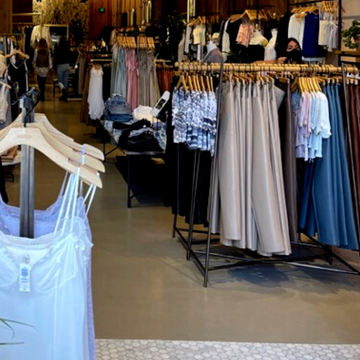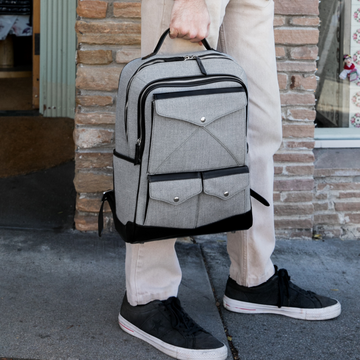The Unholy Alliance of Fashion and Commerce
The fashion industry used to run as nature did, on four seasons. Designers would work for months on crafting and perfecting an offering that they hoped would appeal to consumers.
Today, some of the most recognizable names were born out of this period by designers who had the skill-set to anticipate buyer's tastes for spring, summer, fall, and winter.
As world economies began to grow, so did consumer's disposable income. It was at this point when fashion and mass commerce began to meet.
Netflix's recent biopic of fashion icon Halston gives a glimpse into how this union began. In the 1960s, fashion designers were creating bespoke clothing for the powerful and ultra-wealthy. While it brought cachet, it did not bring in profits.
Many fashion houses were finding themselves on the verge of bankruptcy, their fates decided by the success of their next season's offerings and the pocketbooks of their benefactors.
Halston and other designers found another way. Designers discovered the profit potential of creating accessible fashion for the average, everyday consumer. If they could develop desirable fashion-forward pieces and produce them in factories to keep the cost low, they would tap into a limitless market.
The Emergence of the 52 Seasons of Fashion
The marriage of fashion and commerce was about to become a trifecta of destruction in the early 2000s. Advancements in synthetic fabric technology and rapid manufacturing methods revolutionized the industry.
Instead of guessing what consumers wanted, brands could get immediate feedback from the market and adjust on the fly for their following collection thanks to rapid manufacturing that did not require long lead times.
Fast fashion brands opted to introduce more styles and trendy clothing and accessories – at affordable prices of course- to entice customers to their stores. They wanted to create a buying frenzy among customers. That’s how, over the years, four fashion seasons evolved into 52 micro seasons.
Profits Through Quantity Over Quality
Fashion brands made a fundamental shift in their profit-making approach. Rather than charge high margins for a select number of high-quality items, they would add only a slight margin for an unlimited amount of inventory that could be produced quickly and cheaply.
Author Elizabeth Cline shares with NPR. "They put a small markup on the clothes and earn their profit out of selling an ocean of clothing."
Weekly, stores like H&M, Forever 21, and Zara change their appearance with complete inventory overhauls. With slick advertising, brands can stoke the appetites of buyers around the clock.
While it's easy to blame well-known fast fashion brands, high-end retailers are guilty of it as well. In 2020, Louis Vuitton featured "pre-summer/spring" and "pre-fall/winter" collections. These additional "seasons" were on top of nearly half a dozen collections they released in collaborations with other brands.
While these retail innovations have benefited the fashion industry's bottom line, the adverse effects and damage are now everywhere.
This provided a way for top fashion designers to thrive and innovate. However, this unholy alliance would have catastrophic consequences decades later.
Harming Consumers
The adverse effects of these actions are seen prominently in women's fast fashion, the most profitable consumer segment.
Rapid consumption and turnover cause many to undervalue and reduce their appreciation for their purchases. Because a new season comes every week, people have been conditioned to behave that they should always be "on trend".
Consumers need to stay on the "hamster wheel" of weekly purchasing to maintain their level of happiness. Also, the proliferation of in store and media (online, radio, tv) advertising and promotion is being used to teach the masses that fulfillment is only for those who keep on buying.
In addition to the psychological effects are the socio-economic ones. On the surface, on-trend, inexpensive clothing is a great value proposition, but when you look at the data, the opposite is true.
Disposable fashion buyers wind up spending more when factoring in the volume of clothing and times they have to buy to stay current.
Harming the Environment and Repercussions
To keep up with the demand of the 52 micro seasons, brands have sacrificed the environment to do it.
According to a report by the UN, current industrial practices will cause the world's temperature to increase by 2.7 degrees around the year 2040.
Textile production is only second to oil drilling when it comes to harming the environment.
It's not just the hard costs of clothing production. There are soft ones that consumers don't see. For example, manufacturing plants in the developing world don't report the hundreds of thousands of gallons of polluted water they dump into waterways every month. Harmful chemicals used to dye clothing are emptied into water sources that families in neighboring communities use for drinking.
There is no telling the extent of the human casualties on the citizens of these developing nations because of these horrendous practices.
The picture gets darker when you factor in the entire lifecycle of clothing from manufacturing to the landfill. There are transportation and fuel costs to get clothing from the factory to thousands of different stores and locations.
What happens when items don't sell, and major discounting doesn't help? Unsold items are usually loaded up once again to spend some time on the racks of outlet store locations and e-commerce warehouses.
Even clothing purchased and then donated to thrift stores, and resellers like Goodwill comes at a tremendous environmental cost. According to reports, in California alone, Goodwill spends $7 million on dumping clothes. New York transports 400 million tons of clothing to its landfills each year.
Environmental repercussions of these actions are everywhere.
Virtue Signaling with Dishonest Sustainability
Both large and small fashion brands have seen the writing on the wall. Consumers are now becoming aware of the environmental damage rapid consumerism has had on the environment and are demanding change.
There have been several road blocks for brands on the way towards change. If done incorrectly, pursuing sustainable fashion practices would mean a significant drop to the bottom line. Rather than anger investors, many have opted to mislead purchasers about their effectiveness in becoming sustainable fashion retailers.
These companies are sustainable in advertising, but their practices have yet to hit the mark. For example, retailers may demand higher quality, sustainable materials, but in order to keep their margins, will drive manufacturers to incorporate unsustainable labor practices to achieve their goals.
These workers have few alternatives to their factory jobs, and they will end paying the price with their health and wellbeing.
Many retailers defend their fast-fashion approach by claiming their robust recycling efforts offset the damage, making them more sustainable. Brands will include phrases like "closing the loop on fashion" to brag about all they are doing for the environment through recycling.
According to 2018 data released from the EPA, of the 17 million tons of textiles produced, only 14.7% were recycled. Nearly 11.3 million tons ended up in landfills, where breakdown can take up to 200 years to occur.
The Solution
While it is easy to lump all retailers into the same boat, the reality is that several emerging brands are doing things right. They embrace sustainable "slow fashion" and take the time to educate a new generation of consumers on what it means to have a sustainable wardrobe.
As consumers gravitate towards these brands that focus on high-quality materials and manufacturing processes, it will force other retailers to follow suit.
Education will play a significant role in helping purchasers identify and support ethical fashion brands.
As the Gen Z population comes of age and acquires more purchasing power, there is a new opportunity for retailers to re-evaluate their support of the fast fashion model.
It will be essential to demand our retailers step away from the 52-week fashion cycle and embrace longer seasons and higher quality goods as consumers.
Climate change is on the horitzon. So the journey towards a world of sustainable fashion must happen. Thankfully, more consumers are willing to ask questions and pursue sustainable slow fashion. A growing number of retailers are challenging the assumption that you can't make a profit by sustainably producing high-quality products. As this number grows, the hope of a sustainable future may become a reality soon enough.








